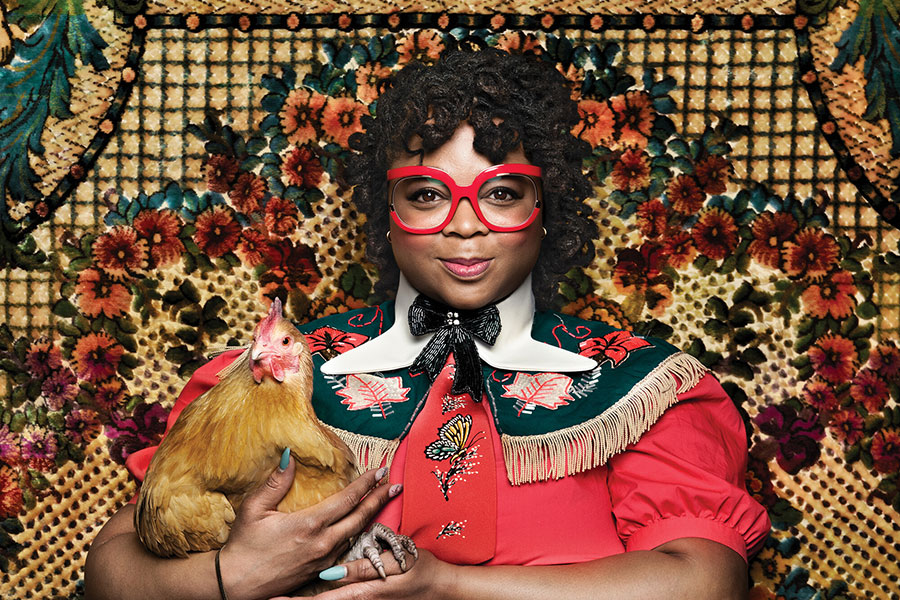
When she was a kid growing up in Crystal, MN, Myah Walker (BS ’10, MPH ’14) had a habit of bringing home stray animals. There were dogs, of course. But there were also less common pets—including baby rabbits, which she hid from her parents.
“They hopped down the stairs and surprised my mom,” Walker says.
Walker’s parents weren’t animal enthusiasts, but they understood their daughter’s interest in them was special. So they encouraged her dreams about becoming a veterinarian, which was the one animal-related career they knew about. Walker became the student who brought home the class pet on weekends. She volunteered at the Animal Humane Society. In high school, she went on a few shadow experiences with veterinarians.
Agriculture, Walker realized, touched on everything, from engineering to nutrition to animal husbandry.
Her mother encouraged her to tour the University of Minnesota, even though the school wasn’t on her initial wish list. Walker’s tour guide on the Twin Cities campus in St. Paul was a poultry sciences major. He told her that while he understood she wanted to become a vet, she should consider agriculture and poultry, and that there were many career opportunities in those fields, especially in Minnesota.
Initially, Walker didn’t give his advice much thought, reasoning that agriculture was for kids who grew up outstate—not city girls. But she had fallen in love with the campus in St. Paul, where much of the animal-related education takes place.
During her sophomore year, a retired poultry veterinarian visited one of Walker’s animal sciences classes to talk about the Midwest Poultry Consortium (MPC), a group that supports the poultry industry through research and education. It offered a two-summer-intensive program on everything poultry, from enterprise to nutrition to physiology to turkeys and ducks. The opportunity also included an internship in the poultry industry. She decided to give it a try.
And that’s when Walker discovered that there was a universe of possibilities in the world of ... chickens. The science of egg production alone—mimicking sunrise and sunset in barns to keep production steady throughout the year—fascinated her. Agriculture, she realized, touched on everything, from engineering to nutrition to animal husbandry. And while the campus in St. Paul was populated with students who had grown up on farms, poultry science was very welcoming to anyone who was interested in learning more.
A 2009 summer MPC internship with an egg business was a turning point. Walker loved all of it: hanging out in the barns, learning how employees cared for the birds, and ensuring food safety. A career in poultry science, she discovered, was about a lot more than chickens and eggs.
“You’re looking at where animal health meets human health, and the importance of that in food safety,” she says. “Humans need food to survive. And so if you have healthy animals, you’re going to have a healthy food supply.”
Walker’s internship turned into a 13-year career, where she worked her way from compliance specialist to quality manager to the director of quality, overseeing the food safety of more than 8 million birds. Her work also included performing internal audits, which she tried to shift from a “you’re in trouble” approach to “we’re all in this together.”
“People think that I’m the bad guy, that I’m here to get [them] in trouble,” she says. “And I pride myself on shifting that narrative a little bit. My job exists just to make things better.”
In 2022, a compliance unit supervisor job became available at the Minnesota Board of Animal Health. The agency oversees all domesticated animals in the state, which includes farm animals.
“We are a small agency that covers a lot of ground, and we are doing our best to meet the needs of the people in the state of Minnesota,” Walker says. “A lot of the work that we do is response: responding to disease outbreaks like avian influenza. At the same time, we are investigating potential disease outbreaks. ... And on the back end of that, we’re doing what we can to prevent future outbreaks.”
It’s rewarding work.
“[Just] in the world of avian influenza, I’m proud to say that I’ve been able to see both sides, from industry and response,” she says. “And to see how top-notch we are in Minnesota in disease response, how proactive we are. ... Just being a part of the conversation excites me.”
- Categories:
- Agriculture and Environment
- Health




